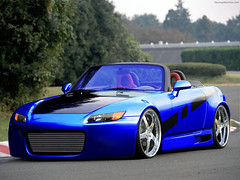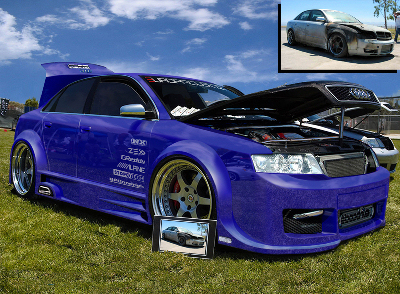 For the 2009 model the G35 sedan was replaced by the G37 sedan. The G37 sedan was first unveiled at the Geneva Motor Show for the European market. Exterior, interior and options remain identical to the 2008 G35 model range but the sedan now also sports the 3.7-liter VQ37VHR "VVEL" V6, rated 328 hp (245 kW) at 7,000 rpm and 269 ft·lbf (365 N·m) at 5,200 rpm that was previously introduced in the G37 Coupe. Although the engine gains only 0.2 kg·m (2 N·m; 1 ft·lbf) peak torque over the VQ35HR and this torque value arrives at a later 5,200 rpm vs. 4,800 in the VQ35HR, the torque curve itsel
For the 2009 model the G35 sedan was replaced by the G37 sedan. The G37 sedan was first unveiled at the Geneva Motor Show for the European market. Exterior, interior and options remain identical to the 2008 G35 model range but the sedan now also sports the 3.7-liter VQ37VHR "VVEL" V6, rated 328 hp (245 kW) at 7,000 rpm and 269 ft·lbf (365 N·m) at 5,200 rpm that was previously introduced in the G37 Coupe. Although the engine gains only 0.2 kg·m (2 N·m; 1 ft·lbf) peak torque over the VQ35HR and this torque value arrives at a later 5,200 rpm vs. 4,800 in the VQ35HR, the torque curve itsel f is improved and flattened across the rpm range via Nissan's new VVEL (Variable Valve Event and Lift) variable valve timing resulting in better throttle response and low rpm torque. The G37's VQ37VHR engine has been touted by car magazines and reviewers as an improvement over the VQ35HR engine mostly adding much refinement and smoother engine operation, especially at high rpm where the VQ35HR engine was frequently criticized for NVH and sounding strained, harsh and loud. The often criticized too aggressive clutch engagement, notchiness of the 6-speed manual in the G35 and engine vibrations transferred through the shifter and pedals in the G35 6MT cars was also addressed in the new G37 models.
f is improved and flattened across the rpm range via Nissan's new VVEL (Variable Valve Event and Lift) variable valve timing resulting in better throttle response and low rpm torque. The G37's VQ37VHR engine has been touted by car magazines and reviewers as an improvement over the VQ35HR engine mostly adding much refinement and smoother engine operation, especially at high rpm where the VQ35HR engine was frequently criticized for NVH and sounding strained, harsh and loud. The often criticized too aggressive clutch engagement, notchiness of the 6-speed manual in the G35 and engine vibrations transferred through the shifter and pedals in the G35 6MT cars was also addressed in the new G37 models. The 2009 sport package (standard on Sport 6MT cars, optional on Journey and X models) now also included larger sport brakes with 4-piston front/2-piston rear calipers and large 14-inch (360 mm) front and 13.8-inch (350 mm) rear rotors and a new 18-inch (460 mm) sport wheel design. The G37 Sedan is available as G37, G37 Journey, G37S 6MT and G37x AWD models. Major option packages remain to be the Premium Package, Sport Package, Nav Package, Tech Package. All 2009 models come standard with self healing "Scratch Shield" paint which employs a soft polymer top coat that can self heal small scratches and swirl marks.
The 2009 sport package (standard on Sport 6MT cars, optional on Journey and X models) now also included larger sport brakes with 4-piston front/2-piston rear calipers and large 14-inch (360 mm) front and 13.8-inch (350 mm) rear rotors and a new 18-inch (460 mm) sport wheel design. The G37 Sedan is available as G37, G37 Journey, G37S 6MT and G37x AWD models. Major option packages remain to be the Premium Package, Sport Package, Nav Package, Tech Package. All 2009 models come standard with self healing "Scratch Shield" paint which employs a soft polymer top coat that can self heal small scratches and swirl marks.
Even though the final drive ratio for vehicles equipped with the 7-speed auto has been (numerically) reduced from 3.69 to 3.36, the new auto has much lower first through fourth gear overall ratios than the old 5-speed auto and the 6-speed manual in the 6MT cars (which retain the old 3.69 final drive ratio). Giving it closer gear ratios in all gears to match engine rpm better with power demand and with the 7th gear being an overdrive to reduce highway cruising rpm and improve fuel mileage. The new 7-speed automatics retain the Drive Sport (DS) shift mode and Downshift Rev Matching (DRM) feature of the 5-speed auto. The new engine/transmission combo did add some weight the car (3,590 lb. for the G37 vs. 3,508 for the G35 in identical trim).




















































 The fourth-generation Spyder Eclipse was released for the 2007 model year at the North American International Auto Show.
The fourth-generation Spyder Eclipse was released for the 2007 model year at the North American International Auto Show.











